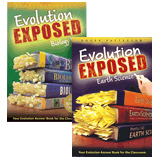
Evolution Exposed: Biology, the Latest Evolution-Combating Resource From Answers in Genesis
Q&A with Roger Patterson, author of the new book
In one sense, it is an attempt to correct some of the mistakes of my past. I have a burden for ministering to youth, and as a high school teacher I had the opportunity to influence many students.
Q: Why did you write this book?
In one sense, it is an attempt to correct some of the mistakes of my past. I have a burden for ministering to youth, and as a high school teacher I had the opportunity to influence hundreds of students each year. For the first few years of my teaching career I had not yet realized the importance of accepting the creation account found in Genesis as truth. I taught evolution right out of the textbook and gave all of the standard examples as support for evolution. I gradually became less and less dogmatic in my evolutionary views and discussed other options with the students, something that was not in the curriculum or standards. I eventually got to the point where I realized that evolution was not consistent with my Christian worldview. I felt so deceived and foolish when I began to realize how far from science evolution really is. I had been putting God and science in two different boxes and pretending that God could have used evolution to create the universe. Over my life I have gone from being raised in a religious environment to atheism to agnosticism and eventually I was called to the truth. I want to give students a resource that can help them avoid falling into the pits that I did. I want students to have a resource in their hands when they walk into their biology class that can encourage them in their faith and offer the truth to their classmates and teachers who have not had the opportunity to hear it.
Q: What experiences have helped you write this book?
As I look back over the last 15 years I realize that God has been preparing me for work in this ministry. During my high school and college years I had fallen away from God, mostly because of my Mormon upbringing. I was very interested in science from an early age and accepted evolution as scientific fact. I decided to pursue a teaching degree, and started my education at Boise State University and finished at Montana State University–Billings, both secular universities. During this time I started moving back closer to God thanks to the example and guidance of my wife and others. There was a point in my education, which was saturated with evolutionary and humanistic ideas in both the education and science courses, when I realized that the complex living systems that I was studying could not have happened by chance. As I studied biochemistry, immunology, cell biology, and other topics, the intricate design of a master Designer became so apparent to me. At that point, I was a deistic evolutionist—I accepted the existence of God, but not His personal role in my life.
As I began teaching biology and chemistry in Buffalo, Wyoming, I had the opportunity to become involved in a consortium of teachers from around the state. We worked on developing performance-based assessments and standards for students. Through that experience I became involved with curriculum development within my school district, and helped other districts around the state develop standards and assessment systems. I can see how God was using that period to prepare me for the curriculum development work I am doing here at AiG.
About three years ago, I became convicted about the creation/evolution issue. My wife’s uncle had been sending me books and magazines from AiG for years and I had little desire to study them in the past. It was like God flipped a switch in my heart and I began to consume books, magazines, and DVDs that helped me understand how evolution was inconsistent with the biblical worldview that I had come to accept. I read more in that summer than I had since I graduated from college. A passion for communicating the new understanding that I had found began to burn and I took every opportunity that I had to share it with others at church, in the community, and at school. This journey has led me through many experiences and gives me the ability to look at the issue from many different perspectives. I sometimes wish that I could have proclaimed the truth of biblical authority and the emptiness of evolutionary ideas from an earlier age, but then I wouldn’t have these experiences to draw on. God has a plan for our lives even if we can’t see it at the time.
Q: What kind of research was involved in writing this book?
I sat down and read three of the most popular high school biology textbooks from cover to cover. The books reviewed were the 2006 editions of biology textbooks from Holt, Glencoe, and Prentice Hall. Virtually every public school student will take an introductory biology class in ninth or tenth grade, and it is very likely they will use a textbook from one of these publishers. As I read, I highlighted the evolutionary content and flagged each page with a sticky note—that is the image shown on the front cover. I cataloged each concept in a spreadsheet and recorded the page number, correlating the concepts that were common to the three books. Once I had all of the concepts recorded, I broke them into ten main subjects and each of those became a chapter in the book.
Once the chapters were defined, I found articles, mostly available on the internet, that explained each of the concepts from a biblical creationist perspective. I then wrote a summary for each article. I summarized each of the ten concepts, explaining both the evolutionary and creationist perspectives. I included key definitions to help the reader understand how the language is twisted in many cases. I also worked with Dr. Georgia Purdom, Bodie Hodge, and Dr. John Baumgardner to develop a set of questions that students can ask their teachers to expose some of the flawed ideas in evolutionary philosophy.
Q: Is this the kind of book that someone would sit down and read in an evening?
No, on two accounts. First, the book is 300 pages, so it would take a long evening. Second, the book is intended to be a reference for students, teachers, and parents more than book to read in one sitting. However, there is a lot of information summarized in the book and it gives a current look at the issues involved in the creation/evolution debate.
Q: What if the information in the textbooks changes, as it always does?
We plan to keep on top of that with future editions, but the companion website, www.evolutionexposed.com, will also provide readers with up-to-date information on all of the topics covered in the book.
Q: Is the book intended for students or adults?
Both. The book is primarily written for students in public schools, but it is also appropriate for parents and teachers who want to know what is being taught in the public schools and used as support for evolutionary thinking.
Q: Could homeschoolers or students who aren’t using one of the textbooks you reviewed find the book useful?
Absolutely! This book will provide homeschoolers with exposure to the evolutionary content, yet in a friendly environment. For students who attend private Christian schools, many of which teach evolution, the book can be used as a supplement to whatever is being taught and provide a truly biblical perspective. For students who aren’t using one of the textbooks reviewed, including junior high and college students, there are topical indexes in each chapter that can help them find articles from a creationist perspective. Regardless of what school setting you are in, this book will be a valuable resource.
Q: How is the book organized?
There is an introduction that describes how to use the book, as well as a section that discusses how to ask questions in a Christ-like manner. We are not trying to prompt students to interrupt the teacher and tell him that “evolution is stupid and here’s an article that proves it.” Christian students are ambassadors of Christ in the public schools, and compromising Christian schools as well, and we encourage them to ask the questions in a prayerful and appropriate way.
Each of the chapters covers a major theme in the creation/evolution debate, from the nature of science to the origin of life and the origin of humans. The chapters start with a brief summary, followed by an index table that tells which concepts are covered on certain pages of the textbooks and what articles the students should read to understand each concept from a biblical perspective. A discussion of the evolutionist and creationist perspectives is followed by summaries of the suggested articles, questions for the teacher, and books that offer more information on the topics.
Q: Can students take a book into the science classroom if it talks about God and the Bible?
Christian students have many more rights than they may realize when it comes to religion in the public schools. Basically, if students are allowed to bring any other type of book into the classroom (by Richard Dawkins or Charles Darwin, for instance), then they can bring a book with religious content into the classroom. In order to keep this book out of the classroom, the teacher would have to prohibit all other books from the classroom. I would recommend reading to understand student rights in more detail.
Q: Why do you think this book and this topic are so important in our culture today?
The decay of moral values is evident in every facet of life. This is partially a product of the replacement of Christian values with the humanist religious values in classrooms across the world. Religion hasn’t been removed from the classroom; Christianity has been replaced by humanism—a religion itself. You can’t even watch PBS children’s programming without being exposed to humanistic and evolutionary philosophies that are contrary to biblical teaching. I believe that the naturalistic and humanistic philosophies that accompany evolutionary teaching in the public schools are a major reason for this decay. When children are taught that there are no absolutes and that they are highly evolved apes, they lose their sense of purpose. When we teach children that they are made in the image of God and that He created them and wants to have a relationship with them, they can find worth. Using the Bible as an absolute authority provides a constant view of morality and the expectations that are clearly laid out by the Creator. It must be very confusing for our youth when they hear so many different messages from so-called experts, each with his own “truth” found in humanistic philosophy. I want everyone to know that they can have a special relationship with the One who created them, and that through that relationship, they can have eternal life and live based on a set of absolute standards—standards that don’t change with every new self-help book written.
Q: What about the Research Paper Challenge associated with the book?
In order to encourage students to share their beliefs with others, AiG has been sponsoring a research paper contest. Last year we had over 120 entries and we hope for even more this year. The students are to write a research paper using Evolution Exposed and other resources from AiG and share that with their teachers, fellow students, and pastors, and then write about the experience. The grand prize is a $50,000 scholarship to Liberty University, and the runners-up will receive laptops and other media resources.
Q: How can people purchase the book?
They can visit AiG’s Answers Bookstore or call the AiG customer service department at 1-800-778-3390. We are also offering a special for a limited time: when you buy a case of 26 books you will pay only $3.99 per book, a 75% savings off of the normal price. We are providing this significant discount as an outreach to students who need resources to help them defend their faith in the schools. We would love to see youth pastors or after-school clubs purchase case lots and hand them out to students all across the country.
Recommended Resources

Answers in Genesis is an apologetics ministry, dedicated to helping Christians defend their faith and proclaim the good news of Jesus Christ.
- Customer Service 800.778.3390
- Available Monday–Friday | 9 AM–5 PM ET
- © 2025 Answers in Genesis







